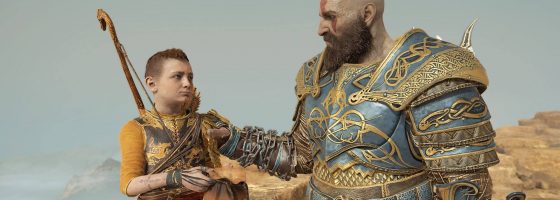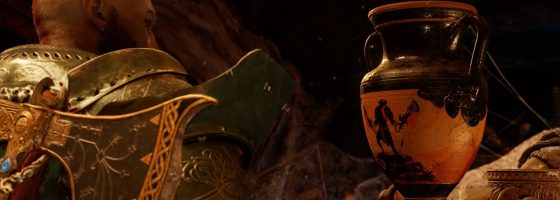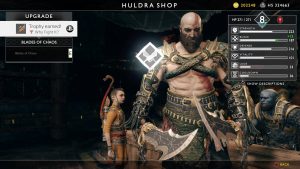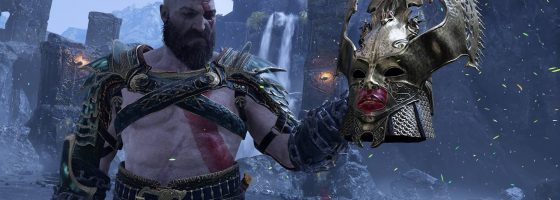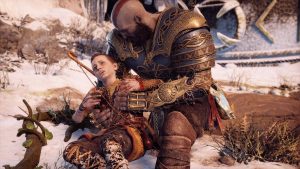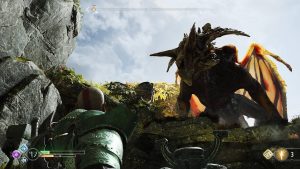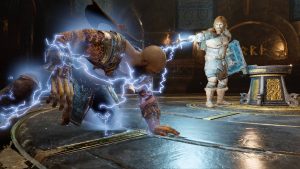The God of War franchise became one of the cornerstones of the Playstation platform thanks to Sony Santa Monica and Lead Designer at the time David Jaffe. Following multiple sequels, side stories, and David leaving the company, God of War entered its own form of purgatory. With Cory Barlog stepping up and years of development, a reinvented God of War was released this year to critical acclaim. Unfortunately for me, I found this to be a game of two minds: an amazing story and direction, with an underdeveloped combat system.
Oh Boy:
The story of God of War 2018 (and we’ll be referring to it as just God of War from here) is a completely new tale from the ground up. Kratos — The angriest Spartan who previously killed all the Greek gods — is now in the Norse land of Midgard. He is now older and fell in love again and had a child by the name of Atreus. After his new wife died, it’s now up to Kratos and Atreus to fulfill her dying wish: To spread her ashes from the top of the highest peak in all the realms.
With Kratos struggling to hide his past and being stalked by Norseman and monster alike, the journey is anything but simple. Off the bat, the story is reminiscent in some aspect to the hit comic “Old Man Logan,” and what happens to someone who lived their life through violence and then had to grow old.
Kratos and Atreus don’t get along, and the great voice acting and mannerisms reflect that. Kratos is no longer the snarling “kill first, ask questions never,” kind of guy; it’s up to him to be a parent and role model to someone who doesn’t follow his same path. The role of father and son is fascinating to watch; with Kratos acting very much like a military or police father who is educating his child with a no-nonsense approach.
While not the same voice actor who originally voiced Kratos (that was Terrence C. Carson), I liked Christopher Judge’s take on the character. He does a good job of presenting an older, wiser Kratos, but still having trouble freeing himself from his rage-filled past.
One subtle element I came to appreciate about the story was just how low-key it was compared to other action games. You’re not trying to save the world, or be a grand hero; you’re just here to fulfill the last wish of a family member. There’s something about being able to take the time to explore the world around you, and have the characters genuinely want to do so as well that makes God of War special.
Just as Kratos’ personality and quest have been altered, so has the game design; with a new focus and combat system.
Axe me a Question:
The days of Kratos unleashing a whirlwind of death and destruction are behind him… in more ways than one. The 3/4th camera system has now been replaced by a third person over the shoulder system similar to the Souls series.
Kratos’s weapon of choice is now the leviathan axe — combining the recall ability of Mjonir with frost powers. The axe itself is very versatile, and is designed for close and long ranged combat. You have a limited set of enhanced options that are unlocked via the skill tree; like an executioner’s strike that does massive damage to a single enemy.
Atreus plays support in every fight, and as the story continues, he becomes more confident in aiding you. At the start, he can be called on by pressing square to shoot an arrow at an enemy — stunning them out of an attack or distracting them off of Kratos.
Further in, he can go in to grapple enemies and provide back-up healing if Kratos is about to die. Atreus can be knocked down and attacked, but he can never be killed.
The biggest change to Kratos’ progression comes in the form of a RPG foundation as opposed to action-adventure design.
+5 to Parenting Skills:
God of War is more RPG than you would assume at the start. Besides the as-for-mentioned skill trees, you are going to be unlocking new gear and modifiers over the course of your adventure. Kratos can wear chest, arm, and waist armor that will raise his base stats. You can also give Atreus new armor, and quivers to change his performance during combat. Enhancements can be bought or found in the world to provide further bonuses, and yes, all gear now has a rarity rating.
You can also upgrade Kratos’s axe and Arteus’s bow to improve their capabilities. The axe and bow upgrades are vital, as they unlock your progress down the respective combat skill trees.
Later in the game, you’ll start to find gear that belongs to specific sets that each part has a unique perk. Most of the late-game optimization comes down to finding a set (or collection of perks) you like, and getting the materials to craft and upgrade them.
The base stats provide minimal impact on your ability to play (more on that later), but also synergize with the runic system. Kratos can attach two kinds of runes to his axe over the game. These runes can either provide special bonuses or unlock “runic attacks” that can be triggered during combat. If your base stats meet the prerequisite, they can further enhance the runes. There are also talismans that can provide short-term buffs that act as the final piece of equipment.
The most important aspect of the gear system that will come into play later in this analysis is Kratos’ level. The higher the quality of gear, the more Kratos’ level will rise.
Everything can also be upgraded if you can find the resources throughout the world, as things are a lot grander this go around.
Taking the Long Way:
God of War follows the trend of recent AAA titles with a focus on open-world exploration. Past the opening act, the game space opens up to reveal multiple areas, hidden quests, and some jaw dropping-ly amazing environments. All the while, Atreus and Kratos will talk about what’s going on and reflect on the areas around them.
The world that Sony Santa Monica has built is amazing, and arguably takes the “Most spectacular looking game on PS4” award that Horizon Zero Dawn had last year. Without spoiling things too much, while the actual game space exists within a localized hub, how you explore will lead to vastly different environments that just get more and more amazing looking. There is also a twist that changes the main hub several times; further increasing the number of different areas to go to.
Many side areas will have the as-for-mentioned resources you need to upgrade, or may lead you to new enhancements or armor pieces to put on Kratos. And it wouldn’t be an open world game without hidden collectibles, upgrades, and nasty enemies waiting for you off the beaten path.
Everything that we’ve talked about so far are great improvements to the design and the best parts of God of War. If we stop things here, this would be a glowing review and one of the best games I’ve played. With that said, it’s time to talk about how things go in reality, and where the experience breaks down for me.
God of Fail:
God of War borrows heavily from the combat design of the Souls series, with the one exception being no stamina to dictate actions. However, the developers didn’t understand one crucial detail about the Souls formula: the design was not built to handle multiple combatants at the same time. The over the shoulder camera obscures enemies not directly in front of the player, and the player’s actions are only really supposed to handle one-on-one fights.
And yet playing God of War, I was constantly fighting 4 or more enemies at the same time. Most of the deaths I had came from enemies attacking me off camera for massive damage. Enemies can also bunch up and attack through each other without any consequence.
When you’re fighting larger mini and full bosses, the camera borrows the same issue from the Souls series with the perspective aimed higher and reducing your vision around. The developers tried to do a band-aid fix by having an “enemy indicator” that shows off when Kratos is about to be attacked off camera.
The problem is that I found this UI element to be broken. There were times when I was attacked and the indicator did not go off previously, or the indicator was up and there was no one attacking me. In a few situations, an enemy would be attacking me off camera and the indicator came up, I ran out of the way and even though I was out of range, it was still telling me of the attack. When you start getting surrounded, I could swear that the indicator was not properly tracking all the attacks.
Not only that, but the direction was not always accurate. If I can’t trust the game to tell me when I’m about to be attacked, then the system falls apart. The other solution the developers put in was to have Atreus’ arrows distract enemies, but I did not find that to be reliable.
One interesting addition in God of War compared to the Souls series was the inclusion of a 180 quick turn. I found this too cumbersome to use, and especially too risky when I’m already fighting two or three enemies in front.
Another frustration point about the camera goes back to the new viewpoint. The over the shoulder view can hide enemy animations behind Kratos’ body — making it impossible to see tells.
There are more issues to discuss. The game makes use of abstracted progression as we talked about for Kratos, but also for the enemies. I found myself watching the mighty Kratos deliver hit after hit to the enemies and their health bar just chipping down slowly (more on this in the next section).
Combat became a massive chore thanks to the limited moves Kratos has. Advanced combos leave you wide open while the animation ends, and the enemy can easily move out of the way.
The bulk of your additional options come in via the runic attacks and Arteus’s support, but they have limited usage and recharge timers.
Without spoiling it too much, you do eventually get three “combat stances” that you can switch to. I would have liked more connection between the three — such as being able to transition smoothly between stances and get more creative with combos.
Most games allow you to stagger enemies to let you keep the pressure on once you’re in your combo. Here, enemies will not be staggered by most light attacks, but only by the heavier, slower attack.
The way enemies attack off and on camera also adds to the frustration. Unless the enemy is directly in front of Kratos, his shield will not block the attack. I had cases of an enemy starting his attack in front, moving to the side during the animation, and then connecting outside of the block distance. Or an enemy who is on screen, but just slightly left or right of Kratos, and the shield block didn’t catch it.
Once you start fighting enemies who have multi-hit combos, they would start their swing off camera, I would dodge out of the way, and then the third hit would connect while I was finishing the dodge animation.
The combat also has some major issues in terms of in consistent results. There were also tons of instances where enemies would start their attack animation, and then slide track to hit me when they were out of range. Sometimes enemies could be staggered, other times they became immune for no discernible reason.
Even your all powerful runic attacks can get you killed, as enemies can attack you while you’re performing the animation, or not get staggered by it and hit you while you’re attacking them. There were also times where I would be in the middle of an animation and could not break it; allowing the enemy to get a free hit.
In terms of non combat-related issues, I wasn’t a fan of how railroaded movement was in terms of where you can and can’t go. However, I understand why they did that in terms of level design, and it’s nowhere near as big of an issue as the rest of my list.
These problems so far have been with the actual combat gameplay, but let’s dig a little deeper into how the game fails to emulate what made the Souls series worked.
Norse Souls:
God of War’s attempt to emulate the slower, precision-focus combat of Dark Souls also fails with its enemies. A major part of the Souls formula, and one that other developers tend to slip up on, is the series’ approach to enemy design.
The reason why there are fewer enemies to fight at once is because each enemy is more complicated than your usual grunts in an action game.
Enemies have different attack patterns, combo chains, and tells that require the player to learn how to read them. This is also why fighting more than one enemy at a time is not advised, due to how advanced they are.
God of War’s enemy designs are just terrible in this regard. Each enemy has at most two to three attacks that they just repeat the same attack animations over and over again. The RPG abstraction is your greatest obstacle to fighting enemies; not the enemies themselves.
Playing God of War at the highest difficulty, enemies proved to be hard to fight not because they were interesting, but because the stats were over tuned on top of the power rating scaling. There is a section early in the game where you have to fight several group waves of enemies with very few options. I’m pretty sure that most people who played on Give me God of War difficulty quit at that part.
God of War runs into the same problem that other action/RPG hybrids have — putting too much of a focus on the RPG side. Any experience you earn simply unlocks new moves, but doesn’t increase Kratos’ level. The only way for you to survive in the game is to find, craft, or upgrade to get better gear. That is a huge turn from other action games and previous God of War titles — where the player becomes better at the game and uses their experience points to add to their power.
Being able to upgrade and customize Kratos was a great idea, but unlike the Souls games that allow you to power up your character with soul levels and gear, God of War is fixed. Your skill trees are locked to the level of your weapons, and the actual resource to upgrade them further is limited to specific events. All the gear and drops in the game are fixed — preventing the player from grinding or using the RPG abstraction to help get pass a hard fight.
The gear itself, for the most part, simply doesn’t mean much in terms of player choices. Stats by themselves don’t do enough to impact Kratos’ abilities. Instead, you want to focus on gear that gives you set perks that complement your style of play. Unfortunately, the majority of said optimization only occurs at the very end of the game and into New Game +; leaving a lot of false choice design in God of War.
Similar to the Borderlands series or Bethesda’s RPGs, enemies have a level attached to them that impacts the abstraction of combat. Trying to fight anything two to three more levels above you becomes hard to the point of impossible. From general observation, I can only assume that the damage dealt/received is scaled up or down depending on the variance in level against who he is fighting. At a four level difference or more, the enemy will kill you in one hit no matter what. In this game, being 99.95% of the way to level 4 will still have the game treat you as level 3 when compared to fighting enemies.
Soulsborne works with designing harder enemies by actually making more complicated or dangerous foes to fight. There’s a sense of accomplishment fighting something that isn’t your usual enemy. Gear is simply used to add to your own utility; not have the game’s balance around it. Here, I felt the designer’s hands making the game purposely difficult instead of engaging to fight.
And speaking of “difficult” I want to talk about the enrage mechanic on Give me God of War difficulty and how it pushes things into cheap territory. Every enemy in the game outside of bosses can become “enraged”; either after taking enough damage or if a specific condition happens during a fight.
When an enemy becomes enraged, they will recover health, gain increased stats, and their moves become more dangerous. Many enemies in their enraged forms become immune to staggering them, which is your main way of focusing them down.
The only ways to stop an enemy once they start the enrage animation are to either hit them for enough damage, or have Atreus shoot them with an arrow. Unfortunately, the game’s design makes this far more difficult (and punishing) than it needs to be. If you’re fighting other enemies, you can’t really stop what you’re doing to engage with the charge up period. That lovely attack indicator doesn’t even give you the heads up that an enemy is enraging off screen.
You would think Atreus would be the answer, but there’s a catch. Atreus will only shoot an arrow at an enemy that you are locked on to (or pointed at if lock-on is not engaged). If you’re fighting multiple enemies at the same time, the lock-on will not engage with an enemy, and there are enemies who move so fast that they break lock-on.
Returning to the staggered issue from the last section, there were plenty of situations where because the enemy couldn’t be staggered, they got a free enrage that prolonged the fight. I don’t know if that’s an explicit game design decision or just a bug left in.
The fall of a God:
I am surprised as to how many people praised God of War completely without having these issues with the base gameplay. Even without playing the game on the hardest difficulty, the cumbersome-ness of the combat and artificial difficulty is very apparent. This is akin to people loving the shiny new paint on a car, but not noticing that it’s leaking transmission fluid all over the place.
Looking at other responses to God of War, I can only draw one conclusion: That the majority of reviewers only played God of War on the normal or easy setting; fewer played it on hard or even looked at the hardest setting.
At one point during my Give my God of War run, there were several sections where I actually fought enemies lower in level to me, and I was able to kill them quickly, they were staggered easily, and I felt like the powerhouse that Kratos was. That feeling must be what it’s like to play the game on the easier settings.
However, and it’s a big however, an action game must be measured by its combat system, and if the combat system isn’t fully working, then the rest of the experience becomes worse in the process. On the lower settings, I can tell that the combat would just be repetitive instead of frustrating, as you’re able to quickly kill enemies and avoid a lot of the issues that I ran into. The issues would still be there obviously, but you would be too busy focusing on the spectacle of combat and destroying everything to notice.
Having to fight multiple enemies wouldn’t be as problematic when you’re able to just kill them before they attack from all sides. Like-wise, your added ability to tank damage would keep you from feeling the hurt if an enemy attacks you through your own animation. The fact of the matter is that these issues should not exist in a top tier action game from a studio who was one of the best in the previous two generations.
God of War is a perfect example of a game that tried to combine action and RPG design without a proper understanding of what makes the design work in the first place.
I can always tell when this happens, as the game becomes easier as you get further in and not more challenging.
The reason is that the player begins to catch up to the abstraction against them, and it stops being a factor. Like-wise, the lack of meaningfully challenging enemies starts to take its toll.
What hurts God of War the most for me is one simple point — Everything else works in this game.
I like the idea of powering up Kratos and Atreus, the story was great, and the environment and art design are gorgeous. If the developers fine-tune the combat and general gameplay with a sequel, this could be one of the best AAA experiences and reinventions this side of Breath of the Wild (and another game that I spent a very long time talking about in a review.)
If you’re expecting a game with the title “God of War” to have amazing combat, prepare to be disappointed. God of War is a game greater than the sum of its parts; how much so depends on what you want out of this game.

